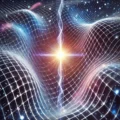Dark Energy: A Time-Domain Resonance Artifact of Charge-Aether Field Asymmetry
Abstract
Dark energy remains one of the least understood components of the current cosmological model. Conventionally described as a smooth, isotropic pressure field accelerating the expansion of the universe, its physical origin remains speculative. In the Charge-Aether (CA) framework, a different interpretation emerges: dark energy is not a form of energy at all in the traditional sense, but a manifestation of time-domain imbalance across energy propagation modes. It arises as a real effect due to the presence of a mirrored, out-of-phase energy domain (−j) that interacts with the measurable (+j) charge-dipole field, influencing the impedance and structure of space itself.
This model reframes dark energy not as a substance but as a resonant imbalance—the visible side of a deeper recursion within the energy-time lattice. Key to this formulation is the replacement of the classical photon with a soliton-like energy transition, which occurs as a single-directional reconfiguration of the field lattice. These events are not persistent particles but momentary lattice transitions bounded by the field’s impedance geometry.
The Energy-Time Split and the Role of −j
The CA model introduces a fundamental symmetry: energy exists in both +j and −j time domains. However, only half of this structure is accessible to observation—the half that aligns with the direction of time we measure via energy transitions. The other half, phase-shifted by 180°, still contributes to field behavior, particularly through:
- Field impedance modulation (seen as dark energy effects)
- Time-symmetric phase mirroring of dipole behavior
- Causal asymmetry in radiative energy (photon events)
This implies that energy exists fully, but only half of it is ever observed in real-time. The other half is coherent, resonant, and invisible—yet it affects measurable outcomes, especially on cosmological scales.
The Dipole as Fundamental Field Actor
Dark energy, from this viewpoint, is not an external force but an emergent result of dipole imbalance at the lattice scale.
- Charge dipoles define field direction and lattice impedance.
- When a charge transitions from one phase state to another, it induces a soliton emission—a single, bounded field reconfiguration.
- The energy visible to us is proportional to the slope of that phase transition.
A photon, then, is simply a record of this soliton’s transition through space—not a packet of energy, but the historical footprint of a dipole’s field reconfiguration.
Soliton vs. Classical Photon
| Property | Classical Photon (QED) | CA Model / Soliton Transition |
|---|---|---|
| Nature | Wave-packet | Single, bounded event |
| Duration | Extended (many λ) | One λ only (360° oscillation) |
| Structure | Gaussian-modulated sine wave | Topology-constrained soliton |
| Sidebands | Required (wave packet dispersion) | None (minimal frequency spread) |
| Energy location | Distributed | Bound to event transition |
| Causal anchor | Superposition, observer collapse | Charge dipole transition → field reconfig |
Is It a Particle?
This reinterpretation brings us to the particle/photon dichotomy. In CA:
A “particle” is not an object, but an event.
| Criterion | Classical Particle | Photon Soliton (CA) |
|---|---|---|
| Localized in time | Yes | Yes |
| Localized in space | No | Yes (event-bound) |
| Carries momentum | Yes | Yes |
| Has extension | Yes (wave-like) | No (bounded, λ-long) |
| Stores energy | Yes | No net (±j cancel); only resonance |
| Exists before detection | Yes | No (emergent during dipole collapse) |
This framework invites a rethinking of “particle” entirely—one that may be reserved for a separate document: “What Is a Particle?” which will loop back to this structure.
Cosmological Implications
In cosmological terms, dark energy may be the macroscopic effect of the latent −j field resonating across space. The vacuum has impedance; the field structure of space is modulated by phase-mirrored energy that does not participate in causal radiation but shifts the field stiffness (Ξ) subtly.
- In high Ξ regions (e.g., gravitational wells), energy binds more easily.
- In low Ξ regions (voids), energy disperses and radiative modes dominate.
Dark energy becomes a reflection of how this Ξ gradient evolves over large scales due to the embedded −j domain’s influence.
Recursive Dependencies
This theory connects recursively with:
- Charge Dipole Field Origins
- Time-Frequency Domain Duality
- Photon Emission as Soliton
- Energy-Time Phase Cancellation
- Black Hole and CMB Field Structures
Each of these should link out to complementary documents in the “Solutions” or “Foundations” sections.
